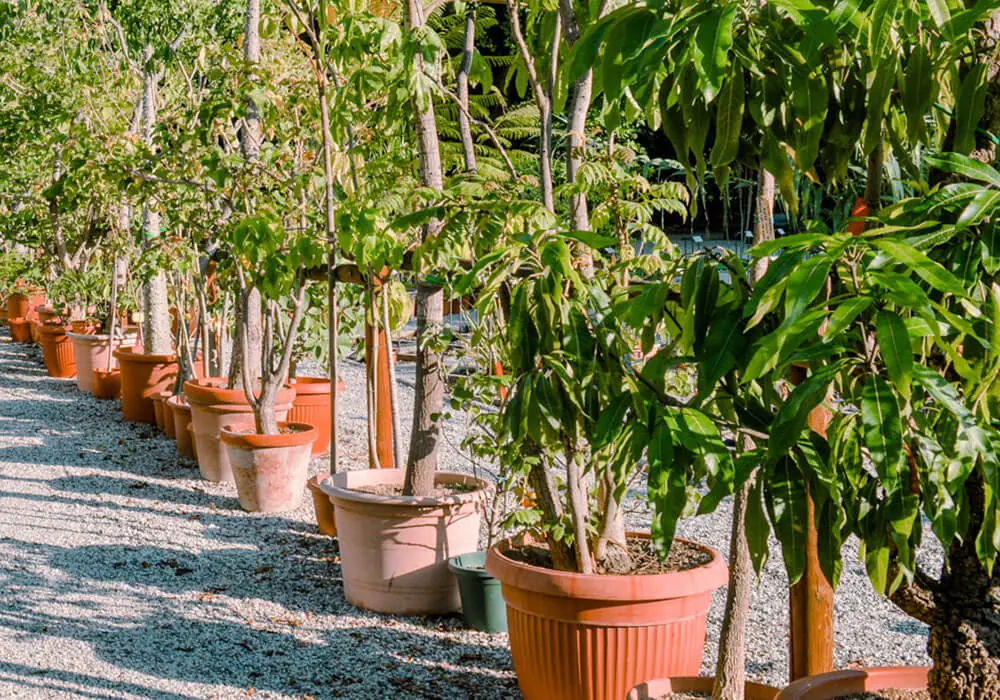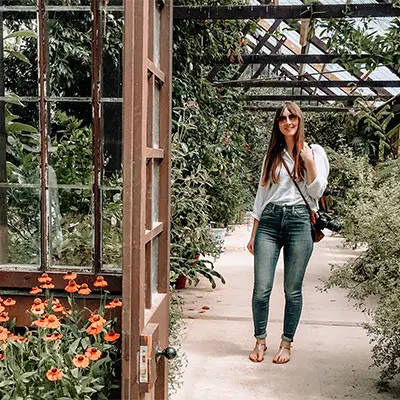12 Small Trees You Can Grow on a Balcony
September, 2022 |Trees can bring so much interest and use to a garden space, from height and shade to fruit and color. However, so many tree species with deep, wide-spreading roots and fast-growing branches that can overwhelm small spaces, we usually assume trees can only be enjoyed in large and medium-sized gardens.
However, you don’t need a big garden to enjoy the benefits that trees can bring. Many smaller tree species grow exceptionally well in containers, and can easily be trimmed and maintained so that they can be kept on a balcony.

Disclaimer: This post contains affiliate links. When you make a purchase through one of these links I may earn a commission. This comes at no extra cost to you.
Small trees you can grow on a balcony
Here are 12 small trees that you can grow in containers on your balcony, or in any mini garden space!
1. Japanese Maple (Acer)
Known for their small height and vibrant foliage, Acer maples are a beautiful tree choice for a balcony. Because of their small size, Japanese maples are a great choice for small garden spaces, and they grow well in containers. They tend to prefer lightly acidic soil, so you might need to adjust your container compost to create the best soil for them.
You can choose from an amazing range of color varieties and leaf shapes, from the purple maple (Acer palmatum) with leaves in shades of auburn, red, and purple. To the striking red and green leaves of ‘Little Princess’ (Acer Palmatum) which turn bright yellow and orange in the fall. If you love plants with pink foliage, definitely check out the ‘Pink Passion’ Acer!
Japanese maples are deciduous trees, which means in winter they will drop their leaves. So while their colorful leaves and blossom will provide a magnificent display, they won’t provide shade or privacy year round. If you’re looking to create year-round privacy, these tall evergreen shrubs and trees may be a more suitable option.
USDA Hardiness Zones: 5 to 8.
Positioning: Suitable for sunny and partially shaded balconies.

2. Citrus Trees
Lemon and lime, or orange and cumquat, citrus trees are great for growing in containers. Citrus trees are evergreen, which makes a lemon or lime tree a great choice for providing privacy or shade year-round. In pots, they’ll usually reach a maximum height of 5ft.
If you live in a cooler climate (USDA zones 7 and below) citrus trees will usually not survive in the ground, so they need to be planted in a container anyway.
If your winters are particularly harsh, you will need to move your citrus tree into a greenhouse or a very sheltered spot with a cover. This winter pot cover and burlap covering from Amazon can help to protect your citrus tree from frosts and winter conditions.
For more tropical flavors, the American pawpaw is an amazing fruit native to the US that’s bursting with tropical flavor. It’s a delicious tropical-tasting fruit that will survive in cooler areas. Especially these cold hardy pawpaw varieties.
USDA Hardiness Zones: 8 to 11.
Positioning: Sunny spot (at least 6 hours of sunlight to fruit).

3. Dwarf Conifer
Dwarf conifer trees are a great evergreen alternative. There are lots of dwarf conifer varieties to choose from. The ‘Hansen’ Balsam Fir (native to North America) has lovely dense, low-growing foliage. However, if you prefer more height you might choose a cedar variety like ‘Silver Mist’ or ‘Holmstrup Yellow’.
Because they’re so compact and slow-growing, it’s unlikely that you’ll ever need to prune them. Plus, many varieties are drought tolerant too, making them an excellent group of low maintenance plants for a balcony.
USDA Hardiness Zones: 3 to 8 (some can survive zones 9 and above but will benefit from partial shade).
Positioning: Suitable for sunny and partially shaded balconies.

4. Olive Tree (Olea europaea)
The gnarled wood and simple, evergreen leaves of the olive tree can be a great addition to a balcony. You can easily prune and trim olive trees to keep them at a desired height or width. They grow slowly, again making them an ideal choice for a balcony or small garden space.
Also great for certain small garden styles, like a Mediterranean or Minimalist garden. Some varieties are ornamental only, so if you’re hoping to harvest olive fruits, make sure you pick the right variety.
USDA Hardiness Zones: 8-11 (may need winter protection in zone 8-9)
Positioning: Sunny spot (at least 6 hours of sunlight to fruit).

5. Bay Tree
Bay trees are a popular choice for topiaries and ‘lollipop’ trees as their foliage can be easily shaped and pruned. They grow incredibly well in pots and provide dense leaves that can provide privacy or shade. They’re also great for keeping bay leaves on hand if you use the fragrant leaves regularly in the kitchen!
USDA Hardiness Zones: 5 to 9 (will need winter protection for zones 6 and below).
Positioning: Suitable for sunny and partially shaded balconies.

6. Dwarf Korean Lilac
Reaching a maximum height of approximately 6ft, the dwarf Korean lilac (Syringa meyeri ‘Palibin’) is a compact and ideal choice for a small garden space or balcony. It’s a small deciduous tree, so it will lose its leaves in winter. However, the mass of fragrant pink/purple flowers in spring and summer really is hard to resist.
USDA Hardiness Zones: 3 to 8.
Positioning: Sunny spot.
7. Pomegranate
A great choice to add height and sweet fruits to your balcony. They’re usually considered to be hardier than citrus trees, but it’s usually best to protect them in frosty conditions.
In colder areas, the tree is usually deciduous, so expect it to lose leaves in harsh winters. This winter protection cover for the pot along with this burlap covering from Amazon can help to keep your pomegranate tree protected.
You can prune a normal pomegranate tree to keep it at your desired height or choose a dwarf or small pomegranate variety (like Red Silk), which usually reaches a maximum height of 6ft.
USDA Hardiness Zones: 7 to 11
Positioning: Sunny spot (at least 6 hours of sunlight to fruit).
8. California Lilac (Ceanothus)
Incredibly attractive to bees and other pollinators, Ceanothus is a great wildlife-friendly tree to grow on a balcony. Delicate blue flowers appear throughout the spring, but the leaves are evergreen.
Some varieties can become quite large, so training your ceanothus to grow vertically is a great way to keep it at a manageable size.
The dense coating of blue flowers will eventually fall throughout the summer, so you may need to sweep up as they fall. However, these can easily be added to your compost bin. If you’re new to balcony composting, this small tumbling compost bin from Amazon helps to aerate your compost and speed up the composting process.
USDA Hardiness Zones: 5-10 (will need winter protection for zones 6 and below).
Positioning: Suitable for sunny and partially shaded balconies.

9. Boxwood Trees (Buxus)
For a slick, modern small garden style boxwood trees (Buxus) are ideal for adding uniform shapes and architectural appeal.
You can buy them in a range of shapes, from spheres and cubes and ‘lollipop’ style trees to simple upright shrubs.
If you’re interested in the art of topiary you could even try shaping your own box tree! These compact topiary shears are a great, affordable option if you’re just trying it for the first time. But for something more professional, these lightweight trimming shears also from Amazon are ideal.
USDA Hardiness Zones: 5-9
Positioning: Suitable for sunny and partially shaded balconies.

10. Dwarf Fruit Trees
There’s now an amazing variety of fruit trees that you can grow in containers. Varieties like the ‘Necta Zee’ nectarine or the ‘Honey Babe’ peach are lovely dwarfing fruit trees that will easily fit onto a balcony.
An espalier or columnar fruit tree is also a great narrow plant option for really tight spaces. They’ll allow you to harvest a crop of fruit in as little as 1 square foot.

11. Dwarf Fig Tree
Generally reaching a height of about 6 feet, dwarf fig trees are a perfect small tree for a balcony. Their large, shaped leaves add interest and a little Mediterranean appeal.
12. Dwarf Crape Myrtle
Another dwarf variety! While crape myrtle trees can reach heights of up to 30 feet (obviously not ideal for the average balcony!). You can find suppliers like The Crape Myrtle Company who offer dwarf varieties!
This means you get to enjoy the gorgeous flush of color in summer, but with a tree that stays at a more manageable size.

Looking after trees on your balcony
Trees can be heavy feeders, so creating your own balcony compost can be a great way to make sure your balcony trees have plenty of nutrients. This makes sure your trees grow into healthy plants with good leaf coverage. For more tree care advice, check out our list of tips for growing trees in containers.







